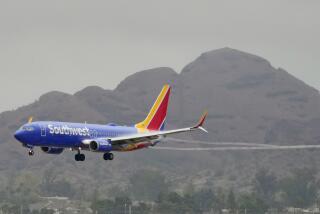For American Airlines, No Gains Before More Pains
- Share via
In the airline business, the reward for agony is more agony.
In recent weeks, AMR Corp., parent of American Airlines, wrung wage and work rule concessions from its employees in confrontations so ugly that its chairman, Donald Carty, resigned under pressure -- all for the sake of reducing its labor costs by a couple of pennies per what the airlines call an available seat mile.
To be sure, those pennies add up. American lopped
$1.8 billion off annual labor costs. It will save $2 billion a year more by rejiggering schedules so fewer flights take off at the same hour. All told, the country’s largest airline has nipped and tucked to cut operating expenses by 23%.
That sounds good, but it’s not going to be enough. American will have to endure even more painful reforms in the years ahead as smaller rivals, with their lower overhead, continue to pinch passengers and prevent American from earning the profit it needs.
In its recent round of cost cutting, AMR’s aim was to reduce its disadvantage against the discount carriers, led by Southwest Airlines. So American will be flying an essentially unchanged schedule but with 20% fewer pilots -- meaning some will be let go and others will fly more hours a month. Flight attendants will be working more for the same money, or less, and with reduced benefits.
If you think you’re impatient for the plane to pull away from the gate, imagine how the flight attendants who just greeted you feel: Under their new contract, they won’t start getting paid until the plane is in motion.
But for all those concessions by employees, their company is still in trouble. Before the new labor agreements, American’s operating costs were 50% higher than those of Southwest and 73% higher than those of JetBlue Airways. Now, American’s costs will be about 30% higher than Southwest’s and 40% higher than those of JetBlue.
That’s quite a differential. AMR’s management says it isn’t worried because, as a spokesman says, American can charge a premium for its tickets and get higher average revenue because it has several vital hubs around the country, offers first-class service “and a mix of fares in the whole cabin.”
In other words, American expects its new closer-to-competitive cost structure to stem the tide of the discounters, which now carry 1 of every 5 passengers in the U.S.
But not everyone buys that. American’s cost cutting is nothing more than “a defensive move,” says analyst Raymond Neidl of Blaylock & Partners, a New York investment firm. “The discounters will continue to gain market share.”
The majors have to do more than squeeze a few pennies per available seat mile. “The major airlines need to change their culture,” says Thomas Petzinger, a Pittsburgh business consultant and author of “Hard Landing: The Epic Quest for Power and Profits That Plunged the Airlines Into Chaos.”
As Petzinger sees it, the majors have to be more like the little guys. Discount airlines come in many shapes and sizes, but they’re all more efficient than the Goliaths they compete against. Nine-year-old Frontier Airlines, for instance, has lower costs than American and other majors because it flies only one type of aircraft, gaining efficiencies in training and maintenance. It offers only economy class, and the meals, notes a spokeswoman, aren’t “fancy shmancy.”
Michael E. Levine, a former senior executive at three airlines and now a law professor at Yale University, says unless there is wholesale change, the major airlines, which carry 80% of passengers, will gradually lose market share until they are left with a mere 25% stake.
American must really do more to “restructure the way it uses its facilities and its workforce” -- far beyond what it already has done, Levine says.
He gives as one example the escalated pay structure for pilots at American, where the bigger the plane, the higher the salary. Labor negotiators at other big carriers have at least flirted with the idea of ditching that structure, but the unions haven’t budged.
Levine points to another tradition he says is a problem. At American, the pilot of a 737 is paid at the same rate as a pilot for Southwest, which has only 737s in its fleet. But Southwest pilots can pull in more money every year because their contract allows them to fly 73 hours a month, while American pilots average only 51 hours a month. So the smaller airline gains certain economic advantages while also offering better opportunities to its personnel.
At the majors, meanwhile, most workers already have seen the good old days of high salaries and glamour disappear.
“Except for the most senior executives and senior pilots, this industry does not offer exceptional jobs,” says Barbara Beyer, president of AvMark Inc., an Arlington, Va., aviation industry consulting firm. “Airline mechanics are paid less than computer repair people, and flight attendants with 30 years of service can make only $56,000 -- but junior attendants make $18,000 to $20,000.”
In the end, the big carriers are in a nosedive they won’t pull out of anytime soon.
The stock market has taken notice, making sharp distinctions among airline companies. Even today, with the industry badly shaken, Southwest stock is off only 16% from its 12-month high and 30% from its all-time best. AMR stock is selling at an 84% discount from its 52-week high -- and a 95% discount from its record peak, back in 1998.
Financial markets will force further changes on American and other major airlines in the years ahead. Today’s pain will be followed by tomorrow’s.
*
James Flanigan can be reached at [email protected].
More to Read
Inside the business of entertainment
The Wide Shot brings you news, analysis and insights on everything from streaming wars to production — and what it all means for the future.
You may occasionally receive promotional content from the Los Angeles Times.










